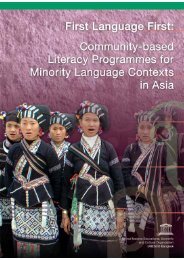Part II.pdf - MTB-MLE Network
Part II.pdf - MTB-MLE Network
Part II.pdf - MTB-MLE Network
You also want an ePaper? Increase the reach of your titles
YUMPU automatically turns print PDFs into web optimized ePapers that Google loves.
efforts by non-governmental organizations. Few, if any, of these projects are actual bilingual<br />
education.<br />
Viet Nam<br />
The Socialist Republic of Viet Nam is a multiethnic and multilingual nation with a population of<br />
about 80 million. Approximately 100 languages are spoken in the country, although the government<br />
officially recognises 54 ethnic groups. Reasons for this apparent discrepancy are similar to those<br />
elaborated on in the case of China. Kinh, or Vietnamese, is the largest ethnic group, accounting<br />
for about 86 percent of the population; ethnolinguistic minorities comprise about 14 percent.<br />
According to the Census of 1999, the combined population of the 53 ethnic minority groups was<br />
slightly more than 11 million. Several minority groups have large populations. The Tay, Thai,<br />
Muong, Hoa (i.e. Chinese) and Khmer have populations of more than one million. Five more groups,<br />
the Nung, Hmong, Dao, Gia Rai and Ede, have populations in the hundreds of thousands. Most<br />
minority groups, however, are smaller. Some 20-30 minority languages already have writing systems<br />
and language development is ongoing in others. (Baulch, Truong, Haughton & Haughton 2002;<br />
Bui 2003; Chazée 1999; Grimes 2000; Kosonen 2004; Leclerc 2004l; Lo Bianco 2002; MOET 2004;<br />
Nguyen 1997; Nguyen 2001; Save the Children-UK 2002; Schliesinger 1997, 1998, 2003; Wright<br />
2002.)<br />
The national language is Vietnamese, and it is used as the LWC in most of the country. Vietnamese<br />
is spoken as the first language (or one first language of bilingual people) by around 90 percent of<br />
the population. The use of ethnic minority languages in education is strongly supported by the<br />
constitution, education laws and many educational policy documents. These documents give equal<br />
support to the learning of Vietnamese by ethnic minority people, thus emphasising bilingual education<br />
(Kosonen 2004; Leclerc 2004l; Save the Children-UK 2002). A goal of the policies is the expanded<br />
and improved quality of multilingualism (Bui 2003; Tran 2003).<br />
Despite supportive policies, Vietnamese remains the main medium of instruction at all levels of<br />
education, in predominantly non-Vietnamese areas, as well. Local languages are used in education<br />
in some areas for programmes referred to as bilingual education (MOET 2004; Nguyen 2003; Tran<br />
2003). In practice, however, most of these programmes teach local languages as subjects or are<br />
transitional with few students actually becoming fully bilingual. In addition, most activities are<br />
top-down in approach, and local communities contribute little, if anything, to the efforts. At least<br />
Hoa, Tay-Nung, Thai, Hmong, Khmer, Cham, Gia Rai, Ede, and Bahnar languages have been used<br />
in pilot projects of mother-tongue education, in pre-primary and primary schools, as well as<br />
non-formal education (APPEAL 2001; Archibald 2003; Jernudd 1999; Kosonen 2004; Malone 2002;<br />
MOET 2004; Save the Children-UK 2002; UNICEF Viet Nam 1998). Government sources<br />
(e.g. MOET 2004) state that more than 10 other languages have been, or are being, used in schools<br />
as “bilingual languages.” Although up to 20 percent of the curriculum could be used for teaching<br />
minority languages, not all schools in minority areas fully use this opportunity. Likewise, according<br />
to the education policy, ethnic minority languages could be the main languages of instruction in<br />
minority area kindergartens, but few early childhood educational institutions implement this policy<br />
(Kosonen 2004; Save the Children-UK 2002).<br />
103
















